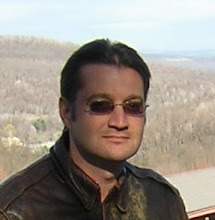Now here was a target worthy of the attention of the Secret Police. Obuszewski was no mere socialist from Takoma Park; he was a nationally-known, almost professional protestor. He was a big fish. He had to be watched.
So the Secret Police began gathering information on Obuszewski. Here is what they found:






The heavily redacted portions of the first two pages raise questions. What did the spies find out about Obuszewski? How did they collect it? Did they search his trash? Did they tap his phones? Did they obtain his financial information? Did they follow him around in his private life? Did they watch his friends and neighbors? We may never know. That’s why they are called the Secret Police!
Despite the spies’ obsession with Obuszewski, they were not rewarded with evidence of illegal activity. To the contrary; the protestors were consistently peaceful. After a 5/24/05 meeting, the spies wrote this about their plans to support Vernon Evans at a court hearing:
The group is planning to meet up outside of the Court of Appeals and “pack the courtroom.” They said they would likely wear armbands to show their support for Evans. The 60 minute oral arguments in Evans’ case are scheduled to start at 1000 hours so the group said anyone who tries to get into the small courtroom should get there at approximately 0915 hours. The people who can’t get in are going to try and stand silently near the courthouse holding signs protesting the death penalty… The group was very firm about any protests being silent and non-disruptive because they were worried about damaging Evans’ case.

But Obuszewski wanted a loud protest outside the Baltimore County State’s Attorney’s office. That piqued the interest of the spies, who reported:
The MSP Annapolis Barrack, Department of General Services Police, Baltimore City Police Department Intelligence Unit, and the Annapolis City Police were informed about the above events.
 Through November, the Secret Police went on to monitor Obuszewski and the other anti-death penalty protestors at two courtroom hearings, one rally and nine internal meetings. Unfortunately for the spies, no illegal activities occurred.
Through November, the Secret Police went on to monitor Obuszewski and the other anti-death penalty protestors at two courtroom hearings, one rally and nine internal meetings. Unfortunately for the spies, no illegal activities occurred.1. At a 6/6/05 Supermax rally, the spies reported, “There were no problems observed at the event.”
2. At a 6/7/05 court hearing for death row inmate Wesley Baker, “There were approximately 10 to 15 anti-death penalty activists who were inside of the courtroom and none caused any problems. There were several additional protestors outside of the courthouse who held signs against the death penalty and they were joined by those in the courtroom when the hearing was over. No problems were observed.”
3. At a 9/2/05 court hearing for death row inmate Vernon Evans, “The people in the courtroom did not cause any type of disturbance during the arguments and no problems were observed. Four members of Evans’ family were also in the courtroom and also did not cause any disturbances. There were no problems observed outside of the courtroom and the group left after the hearing was concluded.”
The vast majority of the spies’ time was spent in meetings with the Committee to Save Vernon Evans, often attended by fewer than ten people. Typically, the attendees discussed publicity around the Evans case, publicity around the death penalty issue generally and sometimes participation in other protests (like those against the war in Iraq). Violence was not discussed. Nevertheless, the spy would sign each report with the simple statement, “Due to the above facts I request that this case remain open and updated as events warrant.” But why?
The spies would soon have their work put to the test. We’ll find out how in Part Three.


No comments:
Post a Comment